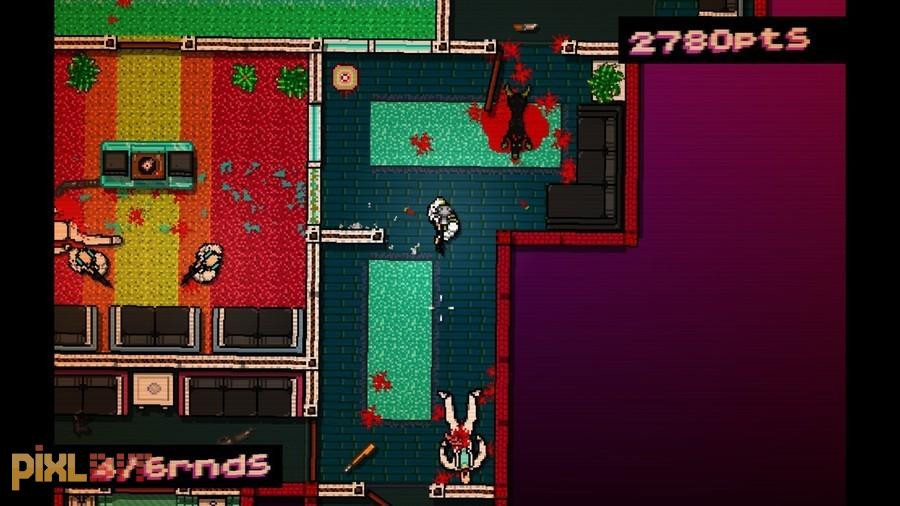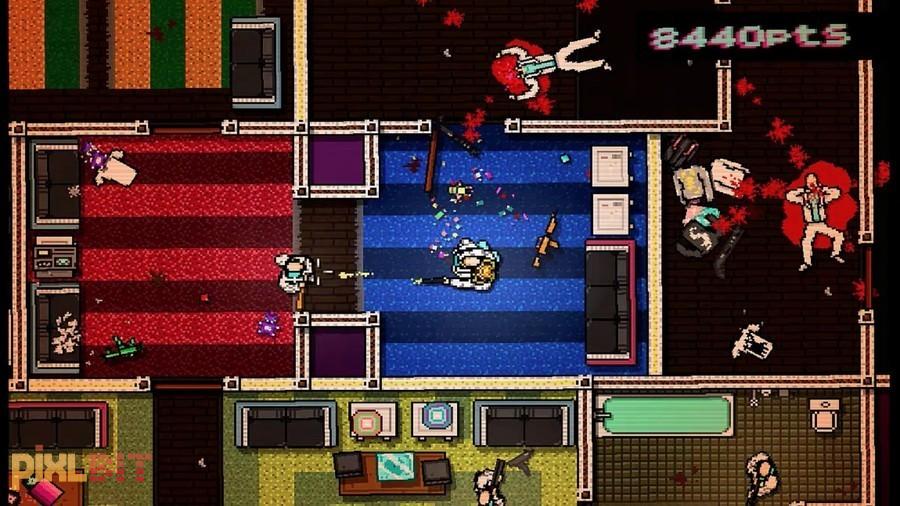I played this game a bit too, and while I think I had more fun with it than you did, I felt like the game was compensating for it's inconsistencies by making the action fast, furious, and graphic. "Oh, did we just screw you over buy having that guard come out a door that he's never used before? just hit "R" and try again instantly! No big deal right?"
Hotline Miami Review
|
|
See PixlBit's Review Policies

On 11/07/2012 at 12:00 PM by Julian Titus It's times like these when I'm happy to know that Jack Thompson was disbarred. |

Fans of hyper violent games.
There’s no denying that social media has transformed the way we get information about video games, especially when it comes to smaller indie titles. I had never heard of the game Hotline Miami until my Twitter feed began to blow up with hyperbolic praise. It was one of the best games of the year! The best soundtrack in the history of video games! The most fun to be had in the digital space…ever. So when we got a review code for the game I jumped all over it, eager to learn what all the fuss was about. Now I’m sitting at my computer and scratching my head, wondering if I missed something, or if I need some of what the people I follow on Twitter are smoking.
Played from a completely overhead perspective ala the classic Grand Theft Auto games, Hotline Miami puts your nameless hitman protagonist through various levels where the goal is to kill. That’s it—just get in there and kill everything that moves, then get out. The catch is that you can die in one hit, and every enemy has an itchy trigger finger that would make Bob Munden cry. The key is figuring out the best path through each level and eliminating the targets quickly, quietly, and ruthlessly.
Taking the enemies out quietly is one of the biggest problems I have with this game. All of the between level tips and even the tutorial would lead one to the conclusion that this is a stealth game, but the inconsistent AI flies in the face of that logic. There’s no good way to tell when an enemy will react to your character; sometimes you can get right behind someone with no problems while other times an enemy will hear your footsteps from across the building and end your life in a flash. Sometimes gunfire will alert the entire floor you’re on and other times no one will even turn to see what the commotion is.
Most of the time, enemies will react with almost prescient awareness of their surroundings, causing frustrating deaths over and over again. Hotline Miami has more in common with a game like Trials Evolution than it does with any type of action game, and even though I got some small amount of satisfaction from clearing a level, it was far outweighed by my annoyance with the erratic AI behavior. Once I figured out my core strategy (let enemies see you, hide behind a wall, attack when they get close), the game was just a repetitive battle of will between my determination to finish the game and my desire to shut it off.
Hotline Miami exemplifies many of the problems I have with indie game design. The formula for so many of these games seems to be “use classic 16-bit pixel art, make it as violent and gory as possible, and throw in a trance-like soundtrack to distract players from how shallow the actual game mechanics are.” I suppose the violence in Hotline Miami is supposed to be “shocking,” what with the arterial spray painting the walls and the bits of brain matter oozing from the skulls of your victims, but I’ve been over that since Smash TV. I get the idea that 16-bit games were mostly kid friendly, and adding a bunch of gore seems edgy and dark. Personally, I see it as a lazy crutch used to get people talking, and besides, there were plenty of games that did the same thing in the ‘90s (Technocop and Time Killers say hi).
I don’t get bothered by violence in video games, but at the same time I’ve matured in taste to a point that violence for the sake of violence annoys me. That’s all that Hotline Miami is—every time I’d kill someone with a bat to the skull or a knife to the throat it felt like the game was saying “f—k yeah, did you see that?! Wasn’t that extreme?” Well, no, it’s not extreme. It’s not even interesting; it’s just tired.
As hardcore gamers that have a vested interest in this hobby, we’re constantly trying to find games to hold up on a pedestal and show to outsiders that, yes, this is art. We defend video games from people like Jack Thompson who think that the only thing to gaming is mindless violence. Hotline Miami is, to me, the type of game that plays right into the hand of people like Thompson. It’s tasteless in every way, with no point to the violence. There’s a semblance of a story in there somewhere, and it almost gets interesting, but never quite goes anywhere. Ultimately this is just 19 levels of carnage that an angst-ridden 17 year old would absolutely love.
Let’s talk about that soundtrack shall we? Hotline Miami is filled to the brim with electronica, synth music, and trance tracks. I’m sure that appeals to plenty of readers out there, but for me the soundtrack to this game was a special level of hell. Droning, repetitive, and mind-numbing, there were many times when I’d have to turn the volume down, wondering what garbage was spewing out of my speakers. I get where the game is coming from, and the music plays well to the ‘80s backdrop. With that said, I hated this type of music back then and time has only cemented that feeling.
I don’t understand the love people were extolling for this game. Shallow, violent to the point of being trashy, and playing off of one repeating game mechanic, Hotline Miami was a miserable experience for me. I’ve grown far beyond the fascination with blood and gore, and the ugly sprite art did nothing for me. A lot of people that I trust on that Twitter feed really loved this game, and that’s fine. We are, after all, entitled to our opinions, but in the future I’ll be more wary the next time everyone I read gushes over a new indie darling.












Comments